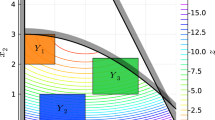Abstract
Chain reduction enables reduced ordered binary decision diagrams (BDDs) and zero-suppressed binary decision diagrams (ZDDs) to each take advantage of the other’s ability to symbolically represent Boolean functions in compact form. For any Boolean function, its chain-reduced ZDD (CZDD) representation will be no larger than its ZDD representation, and at most twice the size of its BDD representation. The chain-reduced BDD (CBDD) of a function will be no larger than its BDD representation, and at most three times the size of its CZDD representation. Extensions to the standard algorithms for operating on BDDs and ZDDs enable them to operate on the chain-reduced versions. Experimental evaluations on representative benchmarks for encoding word lists, solving combinatorial problems, and operating on digital circuits indicate that chain reduction can provide significant benefits in terms of both memory and execution time. The experimental results are further validated by a quantitative model of how decision diagrams scale when encoding sets of sequences. This model explains why the combination of a one-hot encoding of the symbols in the sequences, plus a CBDD, CZDD, or ZDD representation of the set, yields the most compact form.














Similar content being viewed by others
References
Babar, J., Jiang, C., Ciardo, G., Miner, A.: Binary decision diagrams with edge-specified reductions. In: Tools and Algorithms for the Construction and Analysis of Systems, Lecture Notes in Computer Science, vol. 11428, pp. 303–318 (2019)
Bahar, R.I., Frohm, E.A., Gaona, C.M., Hachtel, G.D., Macii, E., Pardo, A., Somenzi, F.: Algebraic decision diagrams and their applications. In: Proceedings of the International Conference on Computer-Aided Design, pp. 188–191 (1993)
Brace, K.S., Rudell, R.L., Bryant, R.E.: Efficient implementation of a BDD package. In: Proceedings of the 27th ACM/IEEE Design Automation Conference, pp. 40–45 (1990)
Brglez, F., Fujiwara, H.: A neutral netlist of 10 combinational benchmark circuits and a target translator in Fortran. In: 1985 International Symposium on Circuits And Systems (1985)
Bryant, R.E.: Graph-based algorithms for Boolean function manipulation. IEEE Trans. Comput. C–35(8), 677–691 (1986)
Bryant, R.E.: On the complexity of VLSI implementations and graph representations of Boolean functions with application to integer multiplication. IEEE Trans. Comput. 40(2), 205–213 (1991)
Bryant, R.E.: Binary decision diagrams. In: Clarke, E.M., Henzinger, T.A., Veith, H., Bloem, R. (eds.) Handbook of Model Checking. Springer, Berlin (2018)
Bryant, R.E.: Chain reduction for binary and zero-suppressed decision diagrams. In: Tools and Algorithms for the Construction and Analysis of Systems, Lecture Notes in Computer Science, vol. 10805, pp. 81–98 (2018)
Bryant, R.E.: Supplementary material regarding chain reduction for binary and zero-suppressed decision diagrams. http://www.cs.cmu.edu/~bryant/bdd-chaining.html (2020)
Daciuk, J., Mihov, S., Watson, B.W., Watson, R.E.: Incremental construction of minimal acyclic finite state automata and transducers. Comput. Linguist. 26, 3–16 (2000)
Daciuk, J., Watson, B.W., Watson, R.E.: Incremental construction of minimal acyclic finite state automata and transducers. In: Proceedings of the International Workshop on Finite State Methods in Natural Language Processing, pp. 48–56 (1998)
Drechsler, R., Becker, B.: Ordered Kronecker function decision diagrams. IEEE Trans. Comput. Aided Des. Integr. Circuits Syst. 17(10), 965–973 (2006)
Fredkin, E.M.: Trie memory. Commun. ACM 3, 490–500 (1960)
Fujita, M., Fujisawa, H., Kawato, N.: Evaluation and improvements of Boolean comparison method based on binary decision diagrams. In: Proceedings of the International Conference on Computer-Aided Design, pp. 2–5 (1988)
Fujita, M., McGeer, P.C., Yang, J.C.: Multi-terminal binary decision diagrams: an efficient data structure for matrix representation. Formal Methods Syst. Des. 10, 149–169 (1997)
Hansen, M., Yalcin, H., Hayes, J.P.: Unveiling the ISCAS-85 benchmarks: a case study in reverse engineering. IEEE Design Test 16(3), 72–80 (1999)
Knuth, D.E.: The Art of Computer Programming, Volume 4A: Combinatorial Algorithms, Part I. Addison Wesley, Reading (2011)
Kunkle, D., Slavici, V., Cooperman, G.: Parallel disk-based computation for large, monolithic binary decision diagrams. In: International Workshop on Parallel and Symbolic Computation, pp. 63–72. ACM (2010)
Malik, S., Wang, A., Brayton, R.K., Sangiovanni-Vincentelli, A.L.: Logic verification using binary decision diagrams in a logic synthesis environment. In: Proceedings of the International Conference on Computer-Aided Design, pp. 6–9 (1988)
Minato, S.: Zero-suppressed BDDs for set manipulation in combinatorial problems. In: Proceedings of the 30th ACM/IEEE Design Automation Conference, pp. 272–277 (1993)
Minato, S.: Binary Decision Diagrams and Applications for VLSI CAD. Kluwer Academic Publishers, New York (1995)
Minato, S., Ishiura, N., Yajima, S.: Shared binary decision diagrams with attributed edges for efficient Boolean function manipulation. In: Proceedings of the 27th ACM/IEEE Design Automation Conference, pp. 52–57 (1990)
Preußer, T.B., Engelhardt, M.R.: Putting queens in carry chains, No. 27. J. Signal Process. Syst. 88(2), 185–201 (2017)
Rudell, R.L.: Dynamic variable ordering for ordered binary decision diagrams. In: Proceedings of the International Conference on Computer-Aided Design, pp. 139–144 (1993)
Somenzi, F.: Efficient manipulation of decision diagrams. Int. J. Softw. Tools Technol. Transf. 3(2), 171–181 (2001)
van Dijk, T., Wille, R., Meolic, R.: Tagged BDDs: Combining reduction rules from different decision diagram types. In: Formal Methods in Computer-Aided Design, pp. 108–115 (2017)
Wegener, I.: Branching Programs and Binary Decision Diagrams: Theory and Applications. SIAM, Philadelphia (2000)
Yoneda, T., Hatori, H., Takahara, A., Minato, S.: BDDs vs. zero-suppressed BDDs for CTL symbolic model checking of Petri nets. In: Formal Methods in Computer-Aided Design, Lecture Notes in Computer Science, vol. 1166, pp. 435–449 (1996)
Acknowledgements
This work has benefited from conversations with Shin-Ichi Minato and Ofer Strichman. This work was supported, in part, by NSF STARSS Grant 1525527.
Author information
Authors and Affiliations
Corresponding author
Additional information
Publisher's Note
Springer Nature remains neutral with regard to jurisdictional claims in published maps and institutional affiliations.
Rights and permissions
About this article
Cite this article
Bryant, R.E. Chain Reduction for Binary and Zero-Suppressed Decision Diagrams. J Autom Reasoning 64, 1361–1391 (2020). https://doi.org/10.1007/s10817-020-09569-6
Received:
Accepted:
Published:
Issue Date:
DOI: https://doi.org/10.1007/s10817-020-09569-6




